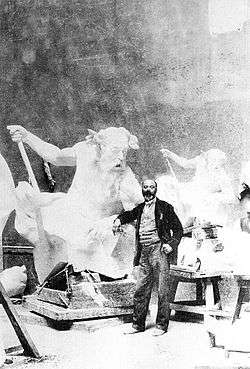Rudolf Weyr

Rudolf Weyr, from 14 May 1911, Rudolf Ritter von Weyr [1] (22 March 1847, Vienna - 30 October 1914, Vienna) was an Austrian sculptor in the Neo-Baroque style.
Life
He studied under Franz Bauer (1798-1872) and Josef Cesar (1814-1876) and was employed by the latter for many years. In 1875, he was contracted by Gottfried Semper and Carl Hasenauer to assist them with their work on the Kunsthistorisches Museum. In 1879, under the direction of Hans Makart, he designed table settings and other decorative pieces for the Emperor's Silver Wedding Anniversary.[2] From the late 1880s, he worked alone and created some of the most important figures that adorn the Ringstraße.
In his later years, Weyr suffered from arteriosclerosis and died of heart failure induced by pneumonia.[3] He was buried in the Döbling Cemetery.[4]
In 1919, a street in Landstraße was named the Weyrgasse in his honor.
Major works
- 1884: Gable statues at the Hermesvilla
- 1888: Spandrel figures in the windows at the Burgtheater
- 1889: Grillparzer Memorial in the Burggarten (with Carl Kundmann); Weyr created the reliefs depicting Grillparzer's dramatic works.
- 1890: Relief figures of the Museum's patrons in the dome of the Kunsthistorischen Museum
- 1895: Fountain: "Die Macht zur See" at the Michaelertrakt in the Hofburg
- 1895: Relief of Vasil Levski on his Memorial Sofia, Bulgaria
- 1898: Emperor Franz-Josef Memorial in Schwechat [5]
- 1905: Memorial to Hans Canon in the Stadtpark
- 1907: Fountain in Děčín, Czech Republic
- 1908: Memorial to Johannes Brahms in the Karlsplatz
References
- ↑ Wladimir Aichelburg: 150 Jahre Künstlerhaus Wien 1861-2011. (…) Mitglieder-Gesamtverzeichnis. In: Weyr von, Rudolf, Bildhauer, 2011, abgerufen am 15. Juli 2012.
- ↑ Oxford Grove Art from Answers.com
- ↑ † Rudolf Weyr. In: Neue Freie Presse, 30. October 1914, p. 23 (Online at ANNO)
- ↑ Statt jeder besonderen Anzeige (…) Rudolf Ritter v. Weyr (…). In: Neue Freie Presse, 31. October 1914, p. 20 (Online at ANNO)
- ↑ Correspondenzen. (…) Schwechst. Denkmalenthüllung. In: Badener Zeitung, 14. September 1898, p. 04 (Online at ANNO).
External links
| Wikimedia Commons has media related to Rudolf Weyr. |
- Rudolf Weyr in: Austria-Forum, the Austrian knowledge network online (at AEIOU)
-
 "Weyr, Rudolf". New International Encyclopedia. 1905.
"Weyr, Rudolf". New International Encyclopedia. 1905.